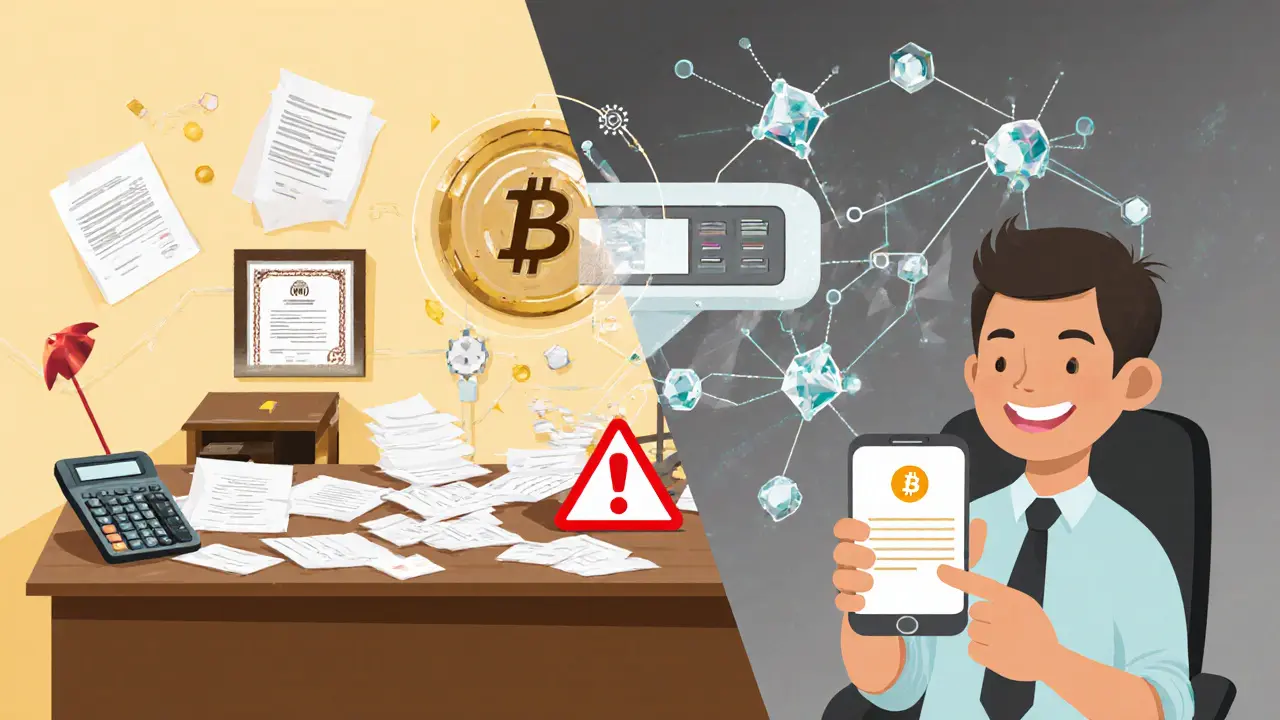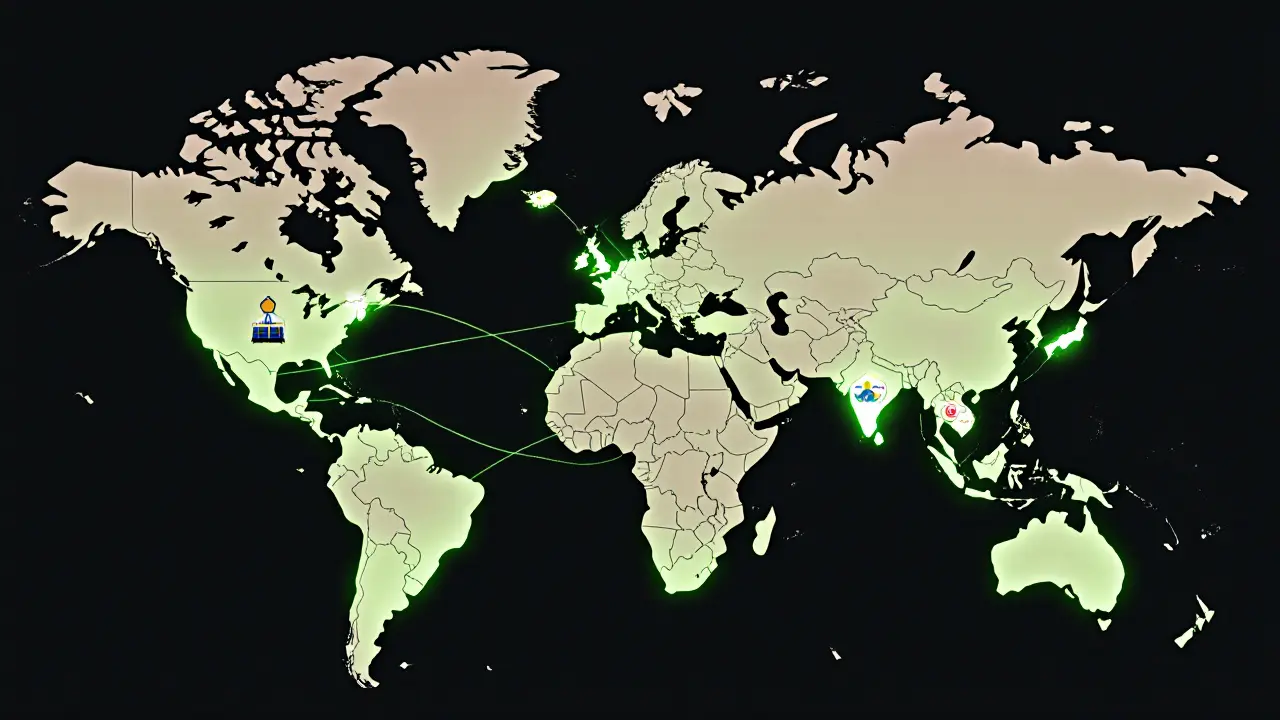Blockchain REC Cost Calculator
Energy Production
System Comparison
Results
Total Energy Value: $3,500.00
Traditional System Cost: $175.00
Blockchain System Cost: $52.50
Potential Savings
$122.50
Percentage
35%
Based on article data: Traditional systems have 5% transaction fees while blockchain systems can reduce this to under 2%.
Every time a wind turbine spins or a solar panel generates electricity, it creates something invisible but valuable: a renewable energy credit. These credits, also called Renewable Energy Certificates (RECs) or Guarantees of Origin (GOs), prove that one megawatt-hour of clean power was added to the grid. Companies buy them to say they’re using green energy-even if their lights are powered by coal-fired plants down the street. But here’s the problem: the system tracking these credits is broken.
For years, RECs moved through paper trails, spreadsheets, and middlemen. A single certificate could be sold, resold, or even claimed twice. Auditors spent weeks verifying data. Transaction fees ate up 5% of every credit’s value. And fraud? It was real. The International Renewable Energy Agency estimated 3-5% of certificates in traditional systems were double-counted or fake. That’s not sustainability-it’s greenwashing with bureaucracy.
How Blockchain Fixes the REC Mess
Enter blockchain. Not the crypto hype kind. The real kind: a digital ledger that records every transaction across hundreds of computers, with no single point of control. Once data is added, it can’t be changed. That’s the key. Every time a solar farm produces 1 MWh of electricity, a smart meter sends the data directly to the blockchain. A digital REC is instantly created and tied to that exact unit of power. No manual input. No middleman. No room for error.
Platforms like the Energy Web Chain a public, energy-specific blockchain launched in 2019 by the Energy Web Foundation, designed to issue and track renewable energy certificates with zero double-counting and Power Ledger an Australian-based blockchain platform that enables peer-to-peer energy trading and automated REC issuance using real-time smart meter data do this automatically. Transactions settle in seconds-not weeks. In Germany’s Microgrid project, administrative time dropped by 70%. Transaction costs fell from 5% to under 2%.
And it’s not just about efficiency. It’s about trust. When a company buys a REC on blockchain, they can see the exact wind farm it came from, the date it was generated, and who retired it. No more vague claims. No more shady brokers. Just transparent, verifiable proof.
Real-World Examples: Where It’s Working
In Australia, Power Ledger’s platform processed over 1.2 million REC transactions in 2023-with zero fraud. Households in Perth sold excess solar power directly to neighbors through the app. Payments cleared in 24 hours. Before? 45 days. One user, u/SolarHomer on Reddit, said: “I finally got paid for my solar power faster than my Netflix subscription.”
In Colombia, Grid Singularity’s blockchain system helped 1,200 small rural energy producers get paid 83% faster than through traditional channels. These weren’t tech-savvy elites-they were farmers and shop owners with solar panels on their roofs. The system worked because it was simple: a text message notified them when their credit was sold. No app download. No crypto wallet. Just SMS.
Even big players are jumping in. Sixty-eight of the Fortune 100 now use blockchain-based RECs for their ESG reports. Why? Because auditors can’t question them. The ledger doesn’t lie.
How It Works Under the Hood
Blockchain-based RECs aren’t magic. They’re built on clear tech layers:
- Smart Meters: These devices measure energy production in real time and feed data directly into the blockchain. No human typing. No delays.
- Tokenization: Each REC becomes a digital token-like a cryptocurrency-but it represents energy, not money. The Energy Web Chain uses ERC-20 tokens, the same standard as Ethereum-based apps.
- Smart Contracts: These are self-executing rules written in code. When a solar farm hits 1 MWh, the contract auto-issues a REC. When a company buys it, the contract transfers ownership and retires it-no paperwork.
- Consensus Mechanisms: Instead of one company approving transactions, hundreds of nodes on the network verify them. This prevents tampering. SHA-256 hashing keeps the data secure.
Restart Energy Democracy in the EU uses a clever twist: two tokens. One lets users access the platform. The other holds the actual REC. That way, even if someone hacks the app, they can’t steal the energy credit.
Power Ledger’s system processes a transaction in 15 seconds. Traditional systems? Days. Or weeks. That speed matters when you’re trying to meet quarterly sustainability targets.

The Downsides: It’s Not Perfect
Blockchain isn’t a silver bullet. It’s a tool-and like any tool, it has limits.
Cost: Setting up a blockchain REC system isn’t cheap. Enterprise deployments cost between $500,000 and $2 million. That’s a barrier for small solar co-ops or rural grids.
Integration: Many energy providers still use 20-year-old metering systems. Connecting them to blockchain requires custom hardware and software. In Kenya, a solar microgrid project failed because 62% of users couldn’t complete transactions-they didn’t own smartphones or know how to use them.
Regulation: The EU recognizes blockchain-verified GOs as legal. The U.S.? Only 18 states have pilot programs. No federal standard. That creates confusion. A REC issued on Energy Web Chain in Germany might not be accepted in Texas.
Fragmentation: There are over 12 competing tokenization standards. Professor Michael Webber of UT Austin warned: “Without standardization, we’re just building new silos.” Imagine trying to trade RECs between two platforms that speak different languages.
Learning Curve: Energy professionals need 40-60 hours of training to use these systems well. Non-technical users often struggle. G2 reviews show 42% of negative feedback blames the “steep learning curve.”
Who’s Using It-and Why
There are three main users:
- Corporations (63%): Big companies like Google, Apple, and Microsoft buy RECs to hit their carbon neutrality goals. Blockchain gives them audit-proof proof.
- Energy Producers (22%): Solar farms and wind operators sell credits directly to buyers, cutting out brokers and keeping more profit.
- Individuals (15%): Homeowners with rooftop solar can sell excess credits to neighbors or local businesses via apps. In Australia, over 350 households traded 4.7 GWh of solar energy in 2023 through Power Ledger.
Europe leads in adoption-78% of EU countries have legal frameworks for blockchain RECs. Asia-Pacific is growing fastest, up 124% year-over-year. The U.S. is playing catch-up, but momentum is building.

What’s Next? The Roadmap
The technology is evolving fast. In January 2024, Energy Web Foundation launched “Origin,” a production-ready platform already used by 47 energy operators across 15 countries. In September 2023, they integrated with the International REC Standard (I-REC), enabling cross-border trading. That’s huge. A solar farm in Spain can now sell a REC to a company in Japan-with full verification.
Coming in Q3 2024: “Auto-Issue.” This feature will generate RECs automatically from smart meter data-zero manual steps. Imagine your solar panels producing power, and a REC appears in your digital wallet without you lifting a finger.
By 2025, blockchain RECs will start tracking carbon co-benefits. Not just “this is clean energy,” but “this energy saved 800 kg of CO2, avoided 200 liters of water use, and supported 3 local jobs.” That’s the future: not just proof of green power, but proof of positive impact.
Gartner predicts only 3-4 major platforms will control 80% of the market by 2026. The rest will fade. Energy Web Chain and Power Ledger are leading. Others are scrambling to catch up.
Should You Care?
If you’re a business trying to prove your sustainability claims? Yes. Blockchain RECs are becoming the gold standard. Auditors, investors, and customers will demand verifiable proof. Paper certificates won’t cut it anymore.
If you’re a homeowner with solar panels? Maybe. Right now, it’s easier to sell credits through your utility. But in five years, peer-to-peer trading via blockchain could be the norm. You might earn more, faster, and with no middlemen.
If you’re an investor in clean energy? The numbers speak for themselves. The global blockchain-in-energy market hit $1.37 billion in 2023. By 2028, it’s projected to hit $12.65 billion. That’s a 56% annual growth rate. This isn’t a trend. It’s infrastructure.
Blockchain won’t fix climate change. But it’s fixing one of the biggest barriers to scaling clean energy: trust. When you know exactly where your green power came from-and who got paid for it-you can believe in it. And that’s the first step to real change.
Chris G
November 19, 2025 AT 20:15Phil Taylor
November 21, 2025 AT 11:54diljit singh
November 22, 2025 AT 19:20Abhishek Anand
November 22, 2025 AT 22:30vinay kumar
November 24, 2025 AT 01:22Lara Ross
November 24, 2025 AT 03:43Leisa Mason
November 24, 2025 AT 17:32Rob Sutherland
November 24, 2025 AT 18:50Tim Lynch
November 25, 2025 AT 23:40Melina Lane
November 26, 2025 AT 00:55Lani Manalansan
November 26, 2025 AT 06:42Frank Verhelst
November 28, 2025 AT 05:42Roshan Varghese
November 28, 2025 AT 06:44Dexter Guarujá
November 28, 2025 AT 15:08Jennifer Corley
November 29, 2025 AT 11:29Natalie Reichstein
December 1, 2025 AT 11:09Kaitlyn Boone
December 2, 2025 AT 15:41James Edwin
December 3, 2025 AT 22:02